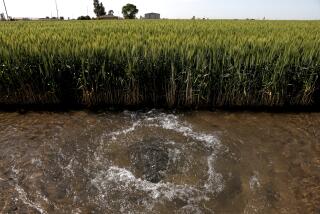Cruise Line Pollution Prompts Legislation
MONTEREY, Calif. — A luxury cruise liner, the Crystal Harmony, has been banished forever from this seaside town by city leaders who were outraged that the ship disgorged 36,400 gallons of wastewater several miles offshore and then waited five months to report the incident.
The ship dumped the waste, which included sewage and bilge water, into the Monterey Bay National Marine Sanctuary, renowned as a refuge for dolphins, whales and other marine life.
“They tried to hide it,” said Carl E. Anderson, Monterey’s director of public facilities. “Months and months later, we learned about it, after pressing them for their records. We don’t think that is a good way to do business.”
The ship’s owner, Crystal Cruises, has apologized for violating a written promise to the city and fired one officer and disciplined two others for violating company policy prohibiting such discharges. But it pointed out that the discharge, which occurred 14 miles offshore, was legal and not subject to disclosure requirements.
“We didn’t violate any rules, regulators or laws,” said company Vice President Joseph L. Valenti. “It was all legal.”
Nonetheless, the Monterey City Council voted unanimously to permanently bar the Crystal Harmony from its harbor, and to ban other ships in the Crystal Cruises fleet for 15 years.
The incident also has propelled California lawmakers to promote legislation to protect waters from cruise ship pollution. If adopted, the legislation would be the toughest law of its kind in the nation. A trio of bills, nearing final passage, would ban all cruise ship discharges within three miles of the state’s coastline.
The legislation also would seek federal permission to forbid sewage, oily bilge water and other polluted waste from being released in national marine sanctuaries, which cover large expanses of ocean around the Channel Islands, the Gulf of the Farallones, Cordell Banks and a stretch of Central California coastline from Cambria to Marin County.
Gov. Gray Davis, who received $10,000 in contributions from the Cruise Industry Community Fund last year, has not said whether he intends to approve the legislation, which is opposed by the cruise ship industry.
The industry says protective measures should be left to informal no-discharge agreements between cruise lines and local authorities -- a position that has been undercut by the events that unfolded earlier this year in Monterey.
Ross Klein, a professor at Canada’s Memorial University of Newfoundland and author of “Cruise Ship Blues,” believes that the “betrayal” felt by authorities in Monterey by Crystal Cruises was stronger than the reaction to the actual spill.
“The industry keeps saying ‘Trust us,’ ” Klein said. “Most politicians and reasonable people take them at their word. But when something like this happens, it makes it an empty sort of statement” and suspicion is spreading with each discharge.
Federal officials have prosecuted cruise lines for dozens of discharges off the coasts of California, Alaska and Florida, resulting in the payment of about $100 million in fines in the last decade. A significant number of the fines were levied for falsifying records or lying to the Coast Guard about ocean dumping that sometimes was legal, but embarrassing for image-conscious cruise lines.
“We need to establish as a matter of law that this behavior will not be tolerated,” said Assemblyman Joe Simitian (D-Palo Alto), the author of two of the three bills moving through the Legislature. “Regrettably, cruise lines have a history of violating their agreements and gaming the system. ‘Trust us’ is no longer an effective environmental policy.”
Cruise ships often carry as many as 5,000 passengers and crew members. In one week, a ship can generate 210,000 gallons of sewage, 1 million gallons of “gray water” from sinks, showers and dishwashers, 37,000 gallons of oil bilge water run through engines and 8 tons of solid waste.
But unlike cities on land, cruise ships are exempt from many provisions of the federal Clean Water Act. Gray water and treated sewage can be discharged in all but a few places set off-limits, such as the Florida Keys. Raw sewage can be dumped anywhere, as long as it is three miles from shore.
Alaska recently adopted laws to require cruise ships to upgrade their wastewater treatment systems so they meet federal effluent standards, and to report such discharges to state and federal authorities.
The California legislation takes a simpler approach: It would ban virtually all wastewater, including treated sewage and gray water, from the ocean within the state’s jurisdiction, which stretches from land to three miles out to sea. It also would seek permission from the U.S. Environmental Protection Agency to extend the ban into four national marine sanctuaries, which cover thousands of square miles of ocean off the coast.
Other states have received EPA permission to establish no-discharge zones, albeit much smaller than those California is considering.
All three bills, which easily passed the Assembly, are to be heard in the Senate Appropriations Committee today. If they are passed by the Senate, they would require some minor amendments in the Assembly.
“The state needs to protect its waters from an industry with an abysmal pollution record,” said Russell Long, executive director of the San Francisco-based Bluewater Network, an environmental group.
But in letters to lawmakers, the International Council of Cruise Lines says that the proposed $25,000 fines are too hefty and that blanket bans do not encourage cruise lines to upgrade their ships with better wastewater treatment systems.
“The state should be encouraging the use of these new systems, not penalizing the ships that install them,” wrote Sande George, a Sacramento lobbyist for the industry.
So far, Davis, through a spokesman, has declined to take a position on the cruise ship pollution bills, although a report prepared by his administration recommends that the state begin inspecting and regulating cruise ships to protect the state’s fish, wildlife and public health.
“Many vessels are not complying with international, state or federal standards in regards to handling hazardous materials, garbage” and discharges or treatment of gray water or sewage, concludes the report, prepared by the state Environmental Protection Agency and the state Water Resources Control Board.
The interagency task force that prepared the report said it found “particularly troubling” the discharging of sludge 12 miles out to sea, and the lack of monitoring of shipboard treatment plants and gray water, which had higher fecal coliform counts than treated sewage.
The task force learned that the Holiday, a 2,052-passenger Carnival Cruises ship, discharged about 19,200 gallons of gray water twice a week at the San Pedro cruise ship terminal from Jan. 1 through mid-May in 2001 while work was being done on tanks and pipes.
But the task force reported that it had been thwarted in its efforts to track hazardous wastes: industry officials reportedly told investigators that tracking the wastes was none of their business because disposal had taken place outside California’s jurisdiction.
The task force has recommended banning the dumping of plastics, solid waste and biohazardous medical wastes in state waters, and requiring cruise ships to treat wastewater to levels required by cities on land. It proposed to pay for this by levying fees on cruise ships based on passenger berths.
The fast-growing cruise industry now has eight major cruise ship lines operating about 20 vessels in California, carrying roughly 650,000 passengers that usually head north to Alaska or south to Mexico. Last year, there were about 280 port calls in San Diego, Long Beach/Los Angeles, San Francisco, Monterey, Eureka and Avalon Bay at Catalina Island, infusing the state’s economy with $1.1 billion and 11,300 jobs, according to the task force.
Nevertheless, Anderson, Monterey’s facilities director, said there had been almost no local resistance to the decision to ban the Crystal Harmony.
“The business community is sophisticated enough to know that a great deal of our economy is based on a healthy environment,” he said. “If we don’t protect it, our economy will suffer.”
More to Read
Sign up for Essential California
The most important California stories and recommendations in your inbox every morning.
You may occasionally receive promotional content from the Los Angeles Times.










